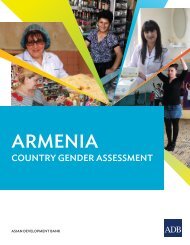Civic Activism as a Novel Component of Armenian Civil Society
English-3
English-3
You also want an ePaper? Increase the reach of your titles
YUMPU automatically turns print PDFs into web optimized ePapers that Google loves.
At times, the public regards activists <strong>as</strong> saviours. Some accounts indicate that the public<br />
feels that it lacks charismatic people who can speak in a highly literate language while also being<br />
accessible to all. Regarding the demand for leadership and the present detachment between the<br />
public and authorities, a 37-year-old female activist highlights the following:<br />
“They were saying things to me like ‘you are our saviour’, and I replied ‘do you not<br />
understand that I am… just pr<strong>of</strong>essional at my job, I am not here to do a revolution, I am<br />
here to unite us around an issue <strong>of</strong> injustice, and now I see what impact it h<strong>as</strong>.’ And I<br />
understood the secret. They like me because I am one <strong>of</strong> them, similar to them. And I<br />
understood that all we need is a connecting link to unite the public with policy makers. It<br />
is nonsense that those who decide on the destiny <strong>of</strong> the public don’t have anything to do<br />
with this very public. I am certain we will be able to deliver success here, to understand<br />
why we have this disconnect, and establish the link.”<br />
Some activists note that although positive public perceptions exist, they are not applied in<br />
practice. In other words, it would be much better if people were to support the initiatives<br />
regardless <strong>of</strong> subject matter. An example <strong>of</strong> such a lack <strong>of</strong> participation by the public is observed<br />
in the Maternity Leave initiative among the husbands <strong>of</strong> the pregnant women who were<br />
advocating for the issue. Another such example is a campaign against a policy for taxi drivers in<br />
Gyumri, which w<strong>as</strong> able only to mobilise drivers without any visible participation by other<br />
groups. It is therefore important to examine the specifics <strong>of</strong> participation. The Electric Yerevan<br />
initiative w<strong>as</strong> a major mobilisation because the issue affected everyone. Being overly selective in<br />
deciding to participate in campaigns is negatively affecting the culture <strong>of</strong> participation in<br />
Armenia.<br />
However, there are examples <strong>of</strong> the public’s positive perceptions having a practical<br />
impact. For example, during the fortnight-long Electric Yerevan campaign, people brought food<br />
to support the protesters. Flyers were distributed during the Dem Em initiative. While people’s<br />
first reaction w<strong>as</strong> “we are not interested”, regarding campaign flyers <strong>as</strong> just another advertising<br />
activity, but after they noticed the Dem Em logo on the paper, most people reacted by taking the<br />
flyer and saying that they would physically join the campaign.<br />
In summary, activists tend to believe that civic initiatives represent the only institutions<br />
trusted by the public. They believe that the public’s perceptions are positive because people have<br />
come to understand the specifics <strong>of</strong> self-organisation. People began to self-organise thanks to<br />
civic initiatives. This is a very good opportunity for them to practice self-organisation, which<br />
leads to positive perceptions <strong>of</strong> and incre<strong>as</strong>ed trust in initiatives.<br />
78



